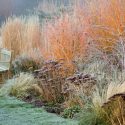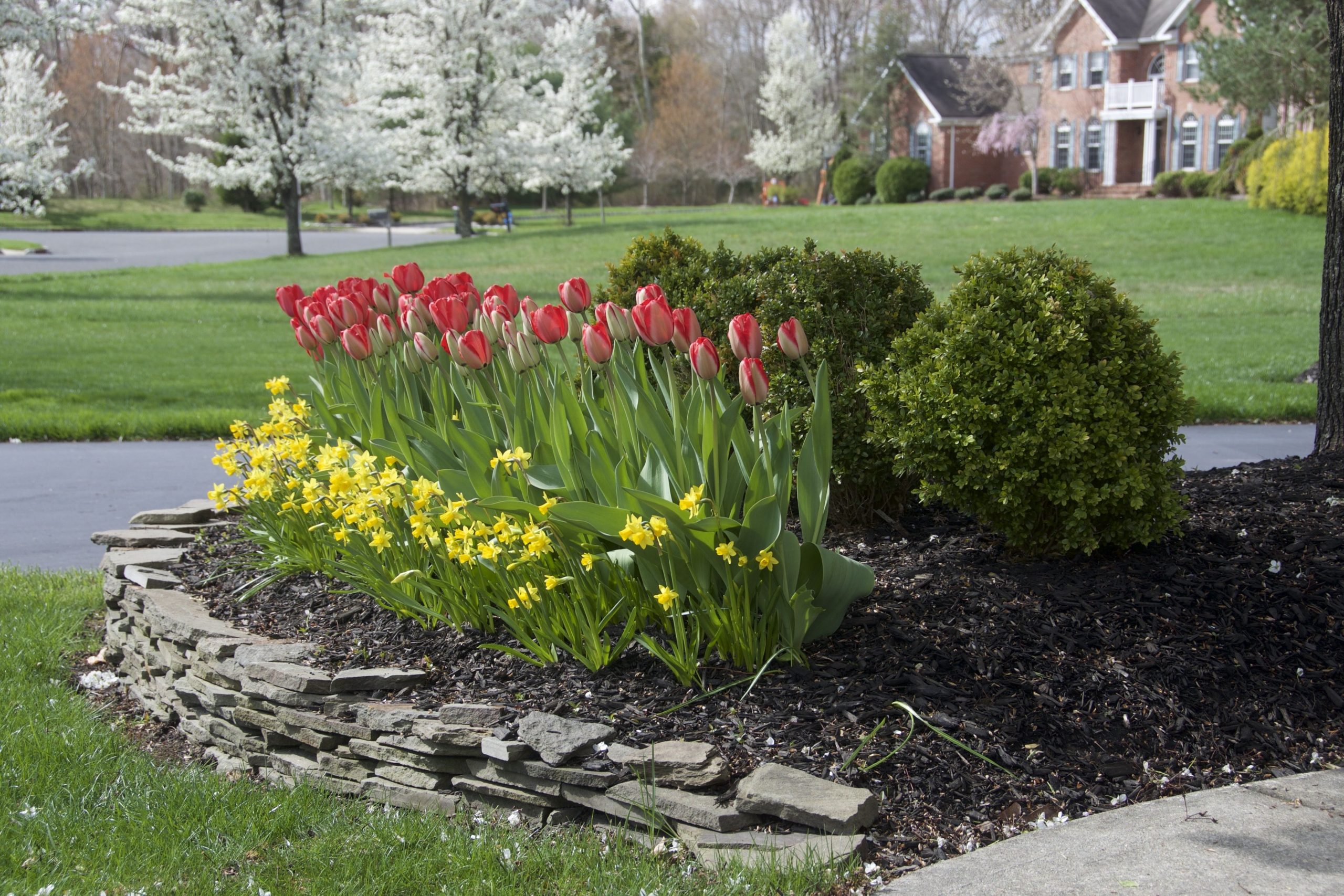Putting together Tulip ‘Jan Reus’ and Daffodil ‘Falconet’ is one of the most beautiful ways to bring spring gardens to life with bright colors. This duo promises to uplift any garden space with their radiant hues and contrasting shapes.
Tulip “Jan Reus”: The deep crimson (almost burgundy) velvety blooms of the tulip “Jan Reus” make it stand out. Its flowers, standing tall on sturdy stems, add drama and intensity to spring borders. They’re particularly breathtaking when the sunlight filters through, illuminating their rich color. The classic shape of the tulip bloom, elegant and cup-like, contrasts wonderfully with the more sprightly daffodil.
Daffodil ‘Falconet‘: On the other hand, Daffodil ‘Falconet’ brings a touch of sunshine to the mix. Its cheerful, small, bright yellow petals surround an orange-red center, radiating warmth and joy. This daffodil variety has a more relaxed, slightly ruffled appearance, giving it a playful edge in the garden.
Putting them together: The deep colors of the ‘Jan Reus’ tulips bring out the fiery heart of the ‘Falconet’ daffodils, making a symphony of colors. This combination works well in borders, where the rich hues can be set off against fresh spring greens. The height difference between the two also adds an element of depth and texture to the garden.
Finally, the combination of Tulip ‘Jan Reus’ and Daffodil ‘Falconet’ is hard to beat for a spring border that really sings with life and color. Their complementary colors and shapes make them garden favorites, promising a show-stopping display year after year.
Few sights announce spring’s arrival as joyfully as vibrant beds of tulips and daffodils. Their cheery blooms in yellow white pink, red, purple, and orange bring lots of color after a long winter.
When used creatively in garden design, these classic spring bulbs can transform your landscape into a breathtaking spring spectacle.
In this article, we’ll cover how to incorporate tulips and daffodils into your yard or garden beds for a gorgeous floral display each spring.
Benefits of Landscaping with Tulips and Daffodils
Here are some of the reasons you should consider using these bulbs in your garden design
-
Provide vibrant early season color – Few plants bloom this brightly in spring
-
Easy to grow – Just plant the bulbs and enjoy the show
-
Excellent cut flowers – Fill vases with beautiful blooms
-
Draw attention – Bright colors attract notice from a distance
-
Versatile sizes – Dwarf to tall cultivars for various uses
-
Fragrant – Many types perfum the garden
-
Naturalize easily – Will spread pleasantly on their own
-
Rodents dislike daffodils – Deer and critters tend to avoid them
With a bit of planning, tulips and daffodils will thrive and furnish weeks of early spring garden magic.
Design Tips for Incorporating Bulbs
Follow these guidelines to design an eye-catching spring bulb display:
-
Plant in groups or sweeps for greater impact
-
Mass a single color for bold splashes of color
-
Mix heights for dimension – use taller and shorter varieties
-
Combine early and late bloomers for longer season
-
Feature them in beds, borders, rock gardens, and pots
-
Allow foliage to die back naturally to nourish bulbs
-
Interplant with annuals, perennials, and groundcovers
-
Use daffodils for naturalizing in lawns and meadows
Best Tulip Varieties for Landscaping
Some top tulips to grow in garden designs include:
-
Darwin Hybrids – Tall, large, vividly colored blooms
-
Fosteriana – Early, chalice-shaped, giant fragrant flowers
-
Greigii – Multiple blooms per stem, broad leaves
-
Kaufmanniana – Multicolored waterlily-type flowers
-
Lily-Flowering – Elegant blooms on shorter plants
-
Parrot – Ruffled, fringed flowers in bright colors
-
Species – Botanical tulips like T. clusiana and T. batalinii
-
Viridiflora – Green-tinged blooms, good for contrasts
Best Daffodil Varieties for Gardens
Top daffodils for landscaping include:
-
Large Cup – Classic yellows like ‘King Alfred’
-
Small Cup – Elegant blooms with petite cups like ‘Tete-a-Tete’
-
Doubles – Full, rose-like flowers such as ‘Replete’
-
Split Corona – Cups split into sections with quirky forms
-
Cyclamineus – Miniature swept-back petals
-
Jonquilla – Clusters of small, fragrant, yellow blooms
-
Triandrus – Clouds of dangling white or yellow flowers
Ideas for Incorporating Bulbs in Garden Designs
Here are some suggested ways to showcase tulips and daffodils in your landscape:
-
Line a driveway or garden path with a ribbon of color
-
Use drifts flowing from flower beds out into lawns
-
Mass bulbs under deciduous trees for spring color before leaf-out
-
Plant sweeps in curve-shaped beds or island beds
-
Place pots along entryways and patios
-
Naturalize bulbs in clusters under shrubs and in meadows
-
Edge vegetable garden with bright tulips for a pop of color
-
Feature complementary colors like purple tulips under yellow forsythias
-
Place pots of blooming bulbs on either side of front doors
Combining Bulbs with Other Plants
The blooming period of tulips and daffodils matches well with many perennials, annuals, and shrubs. Some pleasing combinations include:
-
Yellow daffodils with purple-blue hyacinths
-
Pink tulips under white flowering trees like dogwoods
-
Yellow and red tulips paired with purple pansies
-
Daffodils naturalized under flowering cherry trees
-
Tulips alongside early blooming shrubs like azaleas and viburnum
-
White daffodils mixed with grape hyacinths (Muscari)
-
Orange tulips complementary to purple dead nettle (Lamium)
Caring for Bulbs After Bloom
To help your tulips and daffodils thrive year after year:
-
Allow foliage to die back naturally – leaves fuel next year’s blooms
-
Stop deadheading once hot summer weather arrives
-
Mark bulb locations to avoid disturbing them when digging other plants
-
Remove seed pods on tulips to put energy into bulbs, not seeds
-
Plant annuals over bulb beds to cover fading foliage
-
Lift and divide congested clumps every few years
-
Add bulb fertilizer or compost when planting new bulbs in fall
With proper care, your colorful displays of daffodils and tulips will flourish for years to come. The vibrant flowers make it well worth the extra effort.
Incorporate masses of tulips and daffodils into your spring landscape for a breathtaking floral display. Use them as bold accents or flowing drifts to usher in spring in style. Just add bulbs this fall!
Plants In This Garden
Narcissus ‘Falconet,’ a plant that has won many awards, has cheerful clusters of 3–8 flowers per stem in mid-spring. The petals are deep yellow and overlap, and the cups are bright orange-red. Because of its strong stem and sweet scent, this Tazetta Daffodil makes excellent cut flowers. Ideal for warmer climates, it is perfect for indoor forcing.
| Hardiness | 5 – 9 |
|---|---|
| Season of Interest | Spring (Mid) |
| Height | 1 – 2 (30cm – 60cm) |
| Spread | 2″ – 3″ (5cm – 8cm) |
In mid to late spring, it has amazing dark purple smoky blooms! Tulip ‘Jan Reus,’ a longtime favorite, is very impressive with its very dark red (almost black) blooms that stand out against the pink, apricot, or soft creamy colors of other tulips in arrangements. Grows up to 18-20 inches tall (45-50 cm).
| Hardiness | 3 – 8 |
|---|---|
| Season of Interest | Spring (Mid, Late) |
| Height | 1 – 2 (30cm – 60cm) |
| Spread | 4″ (10cm) |
Learn About These Genera
| Hardiness | 3 – 9 |
|---|---|
| Heat Zones | 1 – 8 |
| Climate Zones | 5, 6, 7, 8, 9, 10, 11, 12, 13, 14, 15, 16, 17, 18, 19, 20, 21, 22, 23, 24 |
| Exposure | Full Sun |
| Season of Interest | Spring (Mid) |
| Maintenance | Low |
| Water Needs | Average |
| Soil Type | Chalk, Loam, Sand |
| Soil pH | Acid, Alkaline, Neutral |
| Soil Drainage | Well-Drained |
| Characteristics | Cut Flowers, Fragrant, Plant of Merit, Showy |
| Landscaping Ideas | Beds And Borders, Patio And Containers |
| Garden Styles | Informal and Cottage, Traditional Garden |

Spring Bulb Tour! Tulips, Daffodils, Anemones and More! Small Space Home Gardening
FAQ
How do I arrange tulips and daffodils in my garden?
Can daffodils and tulips be planted together?
Where is the best place to plant tulips and daffodils?
How to landscape with tulips?
How to plant tulip & daffodil bulbs?
Here’s an essential checklist for soil prep: Check the pH level: Tulips and daffodils thrive in slightly acidic to neutral soil (pH 6 to 7). Ensure good drainage: Avoid waterlogging which harms the bulbs. Add amendments: Mix in organic matter like compost if needed. Timing is crucial; plant your bulbs in the fall before the ground freezes.
Can you plant daffodil and Tulip together?
It is a good idea to mix tulip and daffodil bulbs together while planting. This ensures a longer blooming season in your garden. Just make sure to plant daffodil bulbs a bit deeper than tulips. Tulips and daffodils are highly popular for their bold and spectacular color display. Planting them together can create a dynamic show in your garden.
How do you layer tulips & daffodils?
Here’s how to layer tulips and daffodils: Dig a hole that is at least 8 inches deep and wide enough to accommodate both types of bulbs. Place a layer of soil at the bottom of the hole, followed by a layer of daffodil bulbs, pointed end up, spaced about 6 inches apart. Cover the daffodil bulbs with another layer of soil, about 2-3 inches deep.
How many daffodils should a tulip bed have?
I’ve seen beds of mixed varieties which were very effective, but I prefer groups of the same type interspersed with small bulbs or low perennials. Merry Widow Tulips have dramatic white-edged cherry petals. A section of twenty-or-so bulbs when using tulips; as little as ten for daffodils, create a focal point for the eye.
- The Ultimate Guide to Growing Strawberries in Raised Beds - August 8, 2025
- No-Dig Garden Beds: The Easiest Way to Grow a Beautiful Garden - August 6, 2025
- How to Protect and Preserve Wood for Raised Garden Beds - August 6, 2025

